This Week's Show
This Week’s Show
August 29, 2025
listen / download
Oyster Trash to Treasure
listen / download
Oysters on the half shell are big business on Nantucket Island, and a local program recycles oyster shells from restaurant waste into habitat for young oysters. These recycled oyster shell reefs are helping to protect the coastline from worsening storms and rising seas.
Reef Symphony
listen / download
For a taste of what an oyster reef sounds like, an excerpt of a piece by Living on Earth Producer Sophia Pandelidis about the “symphony” of a reef, with snapping shrimp, grunting fish and grazing urchins all part of this underwater orchestra.
The Outlaw Ocean
listen / download
Seventy percent of our planet is covered by the oceans, but the high seas are among the least-explored frontiers on Earth. And lawlessness is rampant in this vast wilderness, with crimes ranging from illegal fishing to slavery at sea. Pulitzer Prize-winning author Ian Urbina wrote The Outlaw Ocean: Journeys Across the Last Untamed Frontier to tell the harrowing stories of high crimes on the high seas.
The "Little Sea" with a Big Champion
listen / download
The Mar Menor or “little sea” lagoon on the coast of Spain faces impacts from mining, agriculture, and a booming tourist industry. Teresa Vicente helped pass a 2022 law granting the lagoon legal personhood to give it greater protection. She received the 2024 Goldman Environmental Prize for Europe and shares how she led a grassroots movement to protect this beloved lagoon.
Protecting Tenerife's Marine Marvels
listen / download
One of the recipients of this year’s Goldman Environmental Prize is helping to protect an especially biodiverse part of the oceans around the Canary Islands. Carlos Mallo Molina was previously a civil engineer who also loved scuba diving. When he found out about plans to build a massive port on the island of Tenerife that could have devastated the local marine life, he decided to leave construction and dedicate his career to protecting the oceans.
Air Date: August 29, 2025
FULL SHOW
SEGMENTS

Oyster Trash to Treasure
/ Aynsley O’NeillView the page for this story
Oysters on the half shell are big business on Nantucket Island, and a local program recycles oyster shells from restaurant waste into habitat for young oysters. Host Aynsley O’Neill reports on how these recycled oyster shell reefs are helping to protect the coastline from worsening storms and rising seas. (08:26)

Reef Symphony
/ Sophia PandelidisView the page for this story
For a taste of what an oyster reef sounds like, an excerpt of a piece by Living on Earth Producer Sophia Pandelidis about the “symphony” of a reef, with snapping shrimp, grunting fish and grazing urchins all part of this underwater orchestra. (01:02)
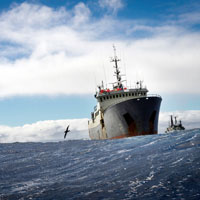
The Outlaw Ocean
View the page for this story
About seventy percent of our planet is covered by the oceans, but the high seas are among the least-explored frontiers on Earth. And lawlessness is rampant in this vast wilderness, with crimes ranging from illegal fishing to slavery at sea. Pulitzer Prize-winning author Ian Urbina wrote The Outlaw Ocean: Journeys Across the Last Untamed Frontier to tell the harrowing stories of high crimes on the high seas, and he joined Host Steve Curwood at a recent live event in Boston. (20:47)

The "Little Sea" with a Big Champion
View the page for this story
The Mar Menor or “little sea” lagoon on the coast of Spain faces impacts from mining, agriculture, and a booming tourist industry. Teresa Vicente is a professor of philosophy of law at the University of Murcia who helped pass a 2022 law granting the lagoon legal personhood to give it greater protection. She received the 2024 Goldman Environmental Prize for Europe and joins Host Aynsley O’Neill to share how she led a grassroots movement to protect this beloved lagoon. (06:03)

Protecting Tenerife's Marine Marvels
View the page for this story
One of the recipients of this year’s Goldman Environmental Prize is helping to protect an especially biodiverse part of the oceans around the Canary Islands. Carlos Mallo Molina was previously a civil engineer who also loved scuba diving. When he found out about plans to build a massive port on the island of Tenerife that could have devastated the local marine life, he decided to leave construction and dedicate his career to protecting the oceans. He joined Living on Earth Executive Producer Steve Curwood. (10:24)
Show Credits and Funders
Show Transcript
Transcript 250829
HOSTS: Aynsley O’Neill, Steve Curwood
GUESTS: Ian Urbina, Teresa Vicente, Carlos Mallo Molina
REPORTERS: Aynsley O’Neil, Sophia Pandelidis
[THEME]
CURWOOD: From PRX this is Living on Earth.
[THEME]
I’m Steve Curwood.
O’NEILL: And I’m Aynsley O’Neill.
Tales of lawlessness and vigilante justice on the open ocean with author Ian Urbina.
URBINA: I got a call from a source at Interpol who said, hey, have you heard about this thing going on down in Antarctica? It's the longest law enforcement chase on the sea. And it doesn't involve law enforcement. It's this conservation group who are sort of chasing this Interpol Most Wanted ship. And I said, wow, that sounds epic. Let me try to see if I can get on board.
CURWOOD: Also, turning restaurant trash into treasure with climate resilient reefs.
KARBERG: This is the very first intertidal oyster reef in Massachusetts. No one had built one of these out here before. So, we thought, ok, we'll do a research project. We'll prove that it's possible to build one of these reefs. We'll show how beneficial it is to the harbor and how it will protect the salt marsh at the same time.
CURWOOD: That and more, this week on Living on Earth. Stick around!
[THEME]
Oyster Trash to Treasure

Living on Earth’s Sophia Pandelidis standing on the “shell mountain” at Nantucket’s Recycling Facility. (Photo: Living on Earth)
CURWOOD: From PRX and the Jennifer and Ted Stanley Studios at the University of Massachusetts, Boston, this is an encore edition of Living on Earth. I’m Steve Curwood.
O’NEILL: And I’m Aynsley O’Neill.
Today on the show we’re pulling up anchor and heading out to sea. Just offshore along many coasts are reefs that provide habitat for oysters, but they’ve declined worldwide by about 85% from before the 1800's, due to overharvesting, dredging, trawling, disease and pollution. That’s not just a problem for those of us who like them as a gourmet dish. Oyster reefs provide natural barriers to combat flooding from worsening storms and rising seas. So, just off the coast of Massachusetts, locals have found an approach to rebuilding reefs that helps their oysters thrive, protects their shores, and fills their bellies. And one lovely summer day, with the help of producers Sophia Pandelidis and Paloma Beltran, I went to find out more.
[RESTAURANT SFX]
O’NEILL: The tiny island of Nantucket thirty miles off the coast of Massachusetts is both sustained and threatened by the steadily rising Atlantic Ocean. Once the whaling capital of the world, Nantucket now teems with up to 50,000 tourists a day who come for its beaches, and its top-of-the-line seafood.
[RESTAURANT SFX]

Living on Earth’s Paloma Beltran, Aynsley O’Neill, and Sophia Pandelidis (left to right) co-produced this story. (Photo: Living on Earth)
O’NEILL: Quahogs, scallops, clams…you name it, Nantucket’s got it. But there’s one shellfish that always gets people talking.
O’NEILL: I’m honestly not sure I like it. [LAUGH]
O’NEILL: Oysters.
O’NEILL: You taste the ocean in this. That is a more pleasant version of opening your mouth while you’re swimming in the ocean.
O’NEILL: So yeah, they’re not my favorite. But a lot of folks who visit Nantucket’s restaurants and raw bars can’t get enough of them. So with that kind of demand, how do you keep the oysters coming? It all starts with the shuck.
[OYSTERS FALLING IN BUCKET]
O’NEILL: In the kitchen of The Sea Grille, Chef Tucker Harvey has mastered the art of oyster shucking.
HARVEY: And then again, you want to slide off the top so you don’t cut the belly.
O’NEILL: A man of few words already, he didn’t have much to say when I asked if he had a special technique. After all, for him, it’s effortless.
HARVEY: The more you do it, the quicker you get, so, yeah. [LAUGH]
O’NEILL: He says his kitchen goes through 1-200 a night.
[SFX OYSTER DROPS]

Griffin Harkins, an Assistant Biologist at the Nantucket Natural Resources Department, holds a bag of “cured” oyster shells ready to head to the hatchery. (Photo: Living on Earth)
O’NEILL: Altogether, Nantucket’s raw bars and restaurants easily dish out hundreds of thousands over the course of a summer season, which leaves the island with a mountain of leftover shells. But they’re not just shucked and chucked. Nantucket has had a shell recycling program since 2014. And Tucker says pitching in is a no brainer.
HARVEY: It’s pretty easy. I mean they provide the all the buckets and everything. We basically just fill them up and leave them outside and then they pick them up.
O’NEILL: At 4:30 every morning, those blue buckets filled to the brim are “schlepped” across the island to begin a process that will bring the oysters full circle.
[AMBI SHELL FACILITY SOUNDS]
[SHELL DUMPING SFX]
O’NEILL: Here at Nantucket’s recycling facility, there’s a stretch of land that’s exclusively for this shell dumping. And those daily deliveries from dozens of restaurants add up fast, so the pile is absolutely towering over me.

Living on Earth’s Aynsley O’Neill tries dumping some of the smelly oysters herself. (Photo: Living on Earth)
HARKINS: I think we have close to a half a million pounds of shells, so it is quite literally a shell mountain.
O’NEILL: Griffin Harkins is an Assistant Biologist at the Nantucket Natural Resources Department and he’s part of the team that hauls those buckets here. Clad in his department baseball cap and t-shirt, Griffin is laid-back, friendly and very helpful as he walks me through the full process. He warns me that even if you’ve got a gourmet taste for these oysters, the process of dumping their shells is definitely not glamorous.
HARKINS: Without further ado, we should drop the tailgate, and open up some buckets, and plug our noses.
[SFX BUCKET OPENING]
O’NEILL: Shells will spend up to a year on these “shell mountains”, undergoing a process called “curing.”
[SFX SHELL DUMPING]
O’NEILL: Out here in the sun, any potentially harmful bacteria and pathogens have time to die off. And the birds and the bugs will take care of any remaining organic matter.
HARKINS: You know, it’s a little dusty, but there are no more meats, there’s no smell to it, and yeah, it’s, it’s good to go.
O’NEILL: So after a year, the shells are bleached and pristine, ready to be reintroduced to the environment with only minimal contamination. From the recycling facility, the shells head to the island hatchery, where they’ll house new life.
[HATCHERY SOUNDS]
O’NEILL: Oysters are threatened worldwide, and local efforts like those at Nantucket’s hatchery can help keep numbers up. Here, biologists nurture all kinds of baby shellfish, called larvae.

The hatchery raises many shellfish youngsters, or larvae. (Photo: Living on Earth)
HARKINS: When you’re looking at larvae under the scope, you can sort of tell a lot of things right away when looking at them, like here you can tell, you know their guts are nice and dark, they're pretty mobile and those are looking like healthy larvae to me.
O’NEILL: Once they’ve grown up a bit, the youngsters will be moved to a giant tub along with a slew of those recycled shells.
[SFX HATCHERY]
HARKINS: So we’re going to bring our shellfish in day one, we bring all adult shellfish and this is usually something that we do between January and February.
O’NEILL: The baby oysters latch on and use the calcium carbonate from the old shells, to create their own new shells. After they’ve grown, many of these oysters are placed in ocean restoration projects.

Griffin Harkins stands at the dock of the Nantucket Hatchery. (Photo: Living on Earth)
[MARSH SOUNDS]
O’NEILL: Some end up here on one of Nantucket’s salt marshes, which are slowly washing away thanks to coastal erosion. But with a project like this, recovery of the marsh is not just possible; it’s happening.
[SFX SQUISHING & WATER]
JISUN: There’s so much!
KARBERG: Mmhmm.
HARKINS: This is incredible.
KARBERG: This wasn’t here last year.
HARKINS: No.
O’NEILL: Jen Karberg, Senior Wetland Ecologist at the Nantucket Conservation Foundation, is the mastermind behind this restoration project, and she brings me out to Polpis Harbor to see what’s going on. She helps me climb into a pair of big, baggy waders before we head out on the reef. Knee-deep in the murky water, I cling to my recording kit and hope nothing gets splashed. We’re making our way to three rows of concrete blocks, or as Jen calls them, “oyster castles”.

The oyster reef is bolstered by mesh bags filled with recycled oysters. (Photo: Living on Earth)
KARBERG: I actually like to think of them as like ecologist legos because they build together and they interlock and they connect together. And then when they're connected, they're pretty stable.
O’NEILL: Before being placed out on the water, these oyster castles took a trip to the hatchery so that oyster larvae could attach to them. And the blocks are also bolstered by mesh bags full of recycled shells with even more growing oyster larvae in tow. Put together, they create the perfect habitat to attract wild oysters and set the reef up to be self-sustaining. With the island expected to get over two feet of sea level rise by 2060, this project could protect the coastline and keep the water clean. That’s because a single adult oyster can filter up to 50 gallons of water a day. And the reef also provides a physical buffer between eroding shorelines and powerful storms that are getting more intense with climate change. The Nantucket Conservation Foundation plus a team of volunteers installed the reef back in 2021.

Climbing into waders was a necessity to visit the reef. (Photo: Living on Earth)
KARBERG: This is the very first intertidal oyster reef in Massachusetts. No one had built one of these here before. So we thought, okay, we'll do a research project. We'll prove that it's possible to build one of these reefs. We'll show how beneficial it is to the harbor and how it will protect the salt marsh at the same time.
O’NEILL: And although the reef is small—just about 40 meters—Jen says it has big potential.
KARBERG: It is really holding up really well. And we’ve had some decent storms in the past two years.
HARKINS: Yeah, especially this past season.
KARBERG: Yeah, and it’s, its here. It’s thriving and the oysters are alive, and I love it, this reef is so exciting for me.
O’NEILL: She says the Foundation will continue studying the ecological impacts and benefits of the reef, and then maybe build more. But these barriers have a barrier of their own: money. While the costs of this first reef were offset by volunteer help, Jen says installing another reef would take at least $20,000. But Jen thinks the project could really set sail if Nantucket’s wealthy homeowners get on board. And there’s an upside for them, too.

Dr. Jennifer Karberg (center), Senior Wetland Ecologist at the Nantucket Conservation Foundation, shows Aynsley O'Neill (left) the reef. (Photo: Living on Earth)
KARBERG: I mean, when you live on the shoreline here, that’s a huge value to your home. You would keep your beach and hopefully improve water quality at the same time.
O’NEILL: The Polpis Harbor reef, built from recycled oysters, could be a model for protecting other shorelines threatened around the world, in a sustainable, circular way. From the ocean to your table, and back again.
Related links:
- Learn more about shell recycling on Nantucket
- Learn more about the Nantucket Conservation Foundation’s Oyster Restoration Project
- MassGov | Nantucket Reef Restoration Project
- Town of Nantucket | “Natural Resources Department: First Oyster Reef Restoration Project”
[MUSIC: Soul Jazz Express, “Crane Beach” on Soul Jazz Express]
Reef Symphony

It appears that oyster larvae are attracted to the sounds of a healthy reef. (Photo: Petras Gagilas, Flickr, CC BY-SA 2.0)
O’NEILL: By the way, what does an oyster reef sound like? A few years ago, our colleague Sophia Pandelidis reported on how reef soundscapes may help baby oysters settle in a safe place. Here’s a taste.
[SNAPPING SHRIMP SOUNDS]
PANDELIDIS: Snapping shrimp, which hide in the nooks and crannies of reefs, dominate this underwater orchestra.
[SNAPPING SHRIMP CONTINUES]
PANDELIDIS: They create air bubbles that pop by snapping their claws together at roughly 60 miles per hour, making them one of the fastest moving creatures in the animal kingdom.
And while researchers say the shrimp take first chair in the underwater orchestra, other creatures add richness to the symphony.
[FISH SOUNDS]
PANDELIDIS: Fish that purr, grunt, whoop, and even honk make up the brass section.

Dominic McAfee, the lead researcher in the restoration project, holds one of the underwater speakers his team developed. (Photo: Dominic McAfee)
[FISH SOUNDS]
And grazing urchins, which scrape algae off rocks with their teeth, bring in the percussion.
[GRAZING URCHIN SOUNDS]
Related links:
- Journal of Applied Ecology | “Soundscape Enrichment Enhances Recruitment and Habitat Building on New Oyster Reef Restorations”
- Journal of Applied Ecology | “The Sound of Recovery: Coral Reef Restoration Success Is Detectable in the Soundscape”
[MUSIC: Joey Alexander, “Draw Me Nearer” on Eclipse, Motema Music LLC]
O’NEILL: Coming up – the risky business of reporting about crimes on the high seas. That’s just ahead on Living on Earth.
ANNOUNCER: Support for Living on Earth comes from the Waverley Street Foundation, working to cultivate a healing planet with community-led programs for better food, healthy farmlands, and smarter building, energy and businesses.
[MUSIC: Lettuce “Blaze” on Resonate, Round Hill Records]
The Outlaw Ocean
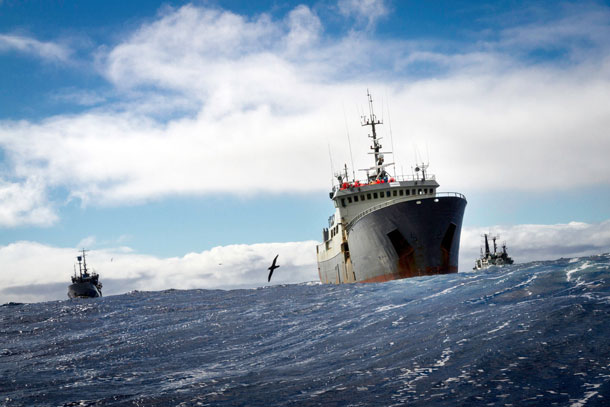
The first story in The Outlaw Ocean focuses on the chase by the Sea Shepherd Conservation Society of the Thunder, an alleged outlaw fishing vessel. (Photo: Courtesy of The Outlaw Ocean)
O’NEILL: It’s Living on Earth, I’m Aynsley O’Neill.
CURWOOD: And I’m Steve Curwood. About seventy percent of our planet is covered by the oceans, yet we know more about the surface of the moon than the deep ocean. With such little attention from society, it’s also no surprise that lawlessness is rampant out on the open ocean, with crimes ranging from illegal fishing to slavery at sea. Investigative journalist Ian Urbina spent a number of years researching and writing his gripping book, The Outlaw Ocean: Journeys Across the Last Untamed Frontier. At times he risked his life in his quest to shed light on the dark corners of our seas. Ian Urbina also founded and directs a nonprofit journalism organization called The Outlaw Ocean Project. In 2019 Ian joined me at the New England Aquarium near our Boston studios for a live event to share some of his stories.
CURWOOD: Ian, let me just start by asking you. The Outlaw Ocean. To what extent do we understand that there's no law out there? I mean, in this society, we live where, hey, if you have a parking ticket, they come for you and they boot your car. I mean, there's a whole system of accountability. And yet out there, there's not.
URBINA: Yeah, so, I approached this space both as a frontier and as an outlaw, by which I mean an extralegal space. It's not the case that there are no laws. There are lots of laws, but the laws are often written in a murky or contradictory way. And then also, laws are only as good as their enforcement. And especially on the high seas, in international waters, there's no, you know, police force that is out there patrolling. So while there are isolated cases of enforcement, they're rare.
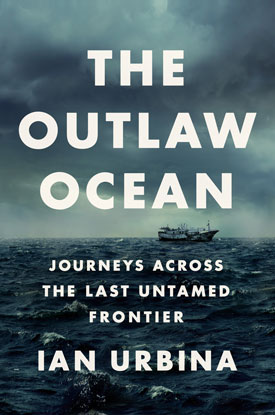
The Outlaw Ocean shares stories of the high seas, where a lack of law enforcement allows lawlessness to run rampant. (Photo: Courtesy of The Outlaw Ocean)
CURWOOD: You decided to, and forgive me about this pun, “bookend” Outlaw Ocean with stories about the Sea Shepherd Conservation Society. What about their journey stood out to you, and especially you have to tell us the story of the Thunder.
URBINA: Yeah, so for those who don't know, Sea Shepherd is this interesting organization, self-described as a vigilante ocean conservation group. It's an organization that has a large fleet of ships and they go around the world patrolling. And so the book is, as you say, bookended with two Sea Shepherd stories. The front story is about Sea Shepherd's campaign to chase the world's most wanted illegal fishing vessel, called the Thunder. And then the last chapter of the book is a look at a very different campaign, which was Sea Shepherd's harassing of Japanese whaling ships that are whaling, arguably illegally on high seas. And so the Thunder, the bottom line with this story was that there has been this purple Interpol list which essentially is a sort of arrest-on-sight list. And ships would be put on this purple list if they had engaged in demonstrable, repeat illegalities over a length of time. And the Thunder, by some metrics, topped the purple list because it had well-documented decade worth of illegal fishing largely in the Southern Ocean, largely aimed at the Patagonian toothfish, also known as Chilean sea bass, and to the tune of $67 million. And Sea Shepherd said, it's very frustrating that there is this list out there. And yet these ships, to a large degree, are allowed to operate without difficulty. They catch their fish legally or illegally. They go into port, they offload, and they go on, and no one ever arrests them. So Sea Shepherd said, we'd like to do something about it. We'd like to sort of show governments that A) we can find these guys and B) then once we find them, we're going to harass them. And that's different from their whaling campaign where they would actually ram the Japanese and do more aggressive things. On this mission, Sea Shepherd decided we're not going to ram them, we're just going to trail them and every time the ship attempts to enter port, we will raise a stink. You know, contact the media, embarrass the local government, et cetera. And the first task was let's start with the Thunder. It tops the list. We got to find these guys. Sea Shepherd did that within two, three weeks; found the Thunder, nets in the water in an illegal space in Antarctica and thus began this sort of epic tale of what became what some folks have said is the longest sort of nautical law enforcement chase in history. And what occurred was these two Sea Shepherd ships, the Bob Barker and the Sam Simon followed and harassed the Thunder over the course of 110 days and over 10,000 miles from Antarctic waters all the way up to the coast of Africa. And spoiler alert, ultimately, after a chase that involved the Thunder going through really perilous ice fields that most folks usually circumvent, they went straight through the middle, you know, Category Four storm that normally ships wait until it passes, the Thunder went through all, trying to lose their tail essentially. But at some point, the Sea Shepherd guys saw the Thunder guys putting their nets back in the water. They cut the nets and took them and the Thunder turned around and began chasing the Sea Shepherd guys. And so it was this really dramatic escapade and ultimately culminated...uh, shall I?
CURWOOD: Well, wait, you were there, though, for part of this. Tell us how you get aboard this, and what you do to get this story.
URBINA: Yeah, so I got a call from a source at Interpol who said, hey, have you heard about this thing going on down in Antarctica? It's the longest law enforcement chase on the sea. And it doesn't involve law enforcement. And I remember thinking, I don't even understand what that means. But I'm interested, you know, and so I said, tell me more. And he said, it's this conservation group who are sort of self-deputized as vigilantes, and they're chasing this Interpol Most Wanted ship and it's getting really hairy and it's been going on forever. And there are all these interesting shadow players involved. And I said, wow, that sounds epic. Let me try to see if I can get on board. I contacted Sea Shepherd, convinced them to help me think of a way for me to get on board the chase without... obviously, the ships couldn't leave their mark, leave their target, so they couldn't come pick me up and then return because they'd lose their target. And so we had to figure out a method for me to get out to certain coordinates that they likely were going to pass through, and then they would quickly pick me up and fall back in line. So that was a challenging task in and of itself. And ultimately, though, we were able to get to those coordinates right at the deadline, got on board, and then I was embedded with them for a while so I could chronicle the story. The story that ends with the Thunder...
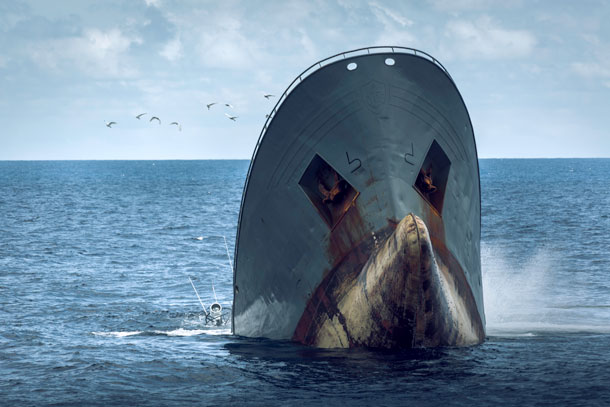
The Thunder as it sinks, shortly after it apparently ran out of fuel following a lengthy chase. (Photo: Courtesy of The Outlaw Ocean)
CURWOOD: Well, but before you get to the end, talk about how you got between the two Sea Shepherd ships to work on the story.
URBINA: So, imagine Navy level ships, and they have high sides. And so the Sea Shepherd vessels obviously don't want to stop at any point. And so the photographer and I wanted to be able to chronicle the experience from both ships, so we had to move back and forth between them. And what that typically means is you get in a smaller boat, and they have a crane that lifts the small boat, and sort of puts it on the water while they're moving. And then you climb down a ladder, and you get in the fast boat. And the fast boat then takes you to the other side, and you do the same thing in reverse. And that ladder process was definitely hair-raising, and especially for my photographer. The funny thing was, this was when I was at the Times, and we had planned to fly this photographer from Brazil, to Ghana, where we were leaving from, and we couldn't get a visa for him in time. So my fixer in Ghana was this young guy who happened to tell me at the last minute, hey, I know how to click a camera. Do you want me to be your photographer? And I said, sure. Are you sure you want to go to sea? I don't know what this is going to be like, it's really… And he said, sure, why not? So I brought him along. And he was amazing. But we were on the vessel and at that very moment, when we were first going to switch vessels, as he was climbing over the railing, he turned to me and said, you know, Ian, thank you so much. This has been the experience of my life. And I said, you're quite welcome. He said, by the way, I don't know how to swim. And I just remember thinking, geez, this guy's life is going to be on my conscience.
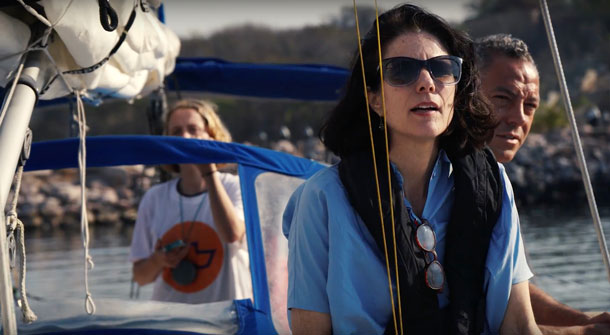
Rebecca Gomperts is a Dutch gynecologist and founder of the Women on Waves organization which provides abortions in international waters offshore of jurisdictions that ban voluntary pregnancy termination. (Photo: Courtesy of The Outlaw Ocean)
CURWOOD: So, you know, I think one of the most striking facts of your story, though, the Sea Shepherds really are breaking the law, they are vigilantes. So, as you've done the research for this work, how often did you have to deal with these sort of morally and legally gray areas?
URBINA: In some ways, the target of the series was the morally and legally gray area. And so as often as I was dealing with it, I was spot on where I wanted to be. And most of the more interesting characters in the book are in that gray space. Whether it's Rebecca Gomperts, a character in the story who provides abortions using a loophole in international law to ostensibly legally provide these abortions, here again, kind of a textbook example of character who's using the law to beat the law.
CURWOOD: Okay, so you have to tell us the story.
URBINA: Yeah, so Rebecca Gomperts, a gynecological doctor, Dutch citizen, worked for Greenpeace for a number of years. And in that work saw some troubling situations with girls and women who needed abortions and could not get access to them. And so she started her own organization called Women on Waves, which essentially, for the past decade and a half, two decades, has operated a ship that goes to countries where abortion is both illegal and often dangerous. And she and her team come into national waters, into port. Usually, surreptitiously, quietly plugs into sort of an underground network of healthcare providers who know of cases of girls and women who are in need, and then quietly brings these women and girls out to international waters. And because the way that maritime law works, such that when you're outside of national waters, the law that applies is the law the flag that you fly. And because her ship is flagged to Austria, the minute the ship would get outside of national waters into international waters, then it becomes legal for her to administer RU-486, pills that would cause an abortion. So, she would do this whole process very quietly, then return the young women back to shore and make sure their anonymity was safe. And then she would hold a press conference to sort of instigate a debate. And that's usually when she would get kicked out the country, as you can imagine.
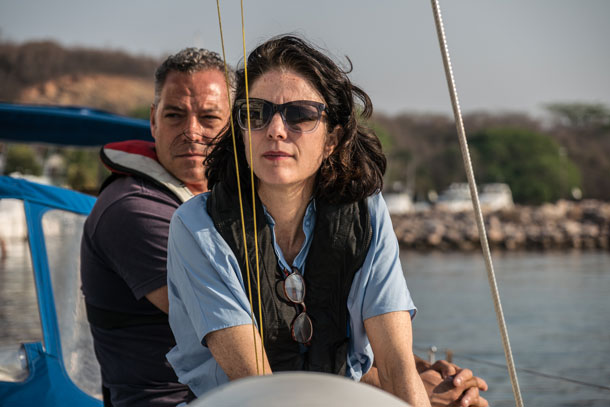
Ian Urbina (left) and Rebecca Gomperts (right). (Photo: Courtesy of The Outlaw Ocean)
CURWOOD: I imagine. So, I have to ask you another adventure story. I think you said your mother swallowed pretty hard when you told her that you were going to Somalia.
URBINA: She was none too pleased.
CURWOOD: And not to spoil the story necessarily, but well, you can tell us whether or not mom was right.
URBINA: Mom is always right, for the record. Yeah. So I told mom very little about actually where I was going before I left. I just said, I'm going to go to Kenya and then I might dip into Somalia. But that's as much as I said. Yeah, the Somalia story was an example of a story where I went in aiming to tell one story, which was actually going to be a good news story about an unusual, successful case of law enforcement where the Somalis and the Kenyans had gotten along and worked together and they caught these repeat offenders. And I did everything by the book because there had been some really bad cases of kidnapping of reporters working on this very topic and so I had permission from the key tribal leaders, et cetera, et cetera. Within a week of being in Puntland, which is mildly put, sort of what Texas is to Washington DC, Puntland is to Mogadishu. In the sense that it is part of the country but, no offense to Texans in the room, but very proudly, defiantly kind of autonomous. And in Puntland's case, it's also the launching zone for a lot of the illegality. So, it's hard to write a book about the outlaw ocean and not go to Somalia, and not go to Puntland specifically. But it's very hard to get into Puntland. The roads are run by ISIS and Al Shabaab. So, you've got to fly in, you can't go by road. And then when you're in there, you got to be really careful about who your security is, et cetera, et cetera. And I thought we had it all set up. The short version, everything went upside down. We ended up losing our security, being told we needed to leave, but there was no plane out, and we had no way to get out. So, we had to hide on the roof of our compound for a while until we could sort of sneak our way out and wait for a plane to come get us.
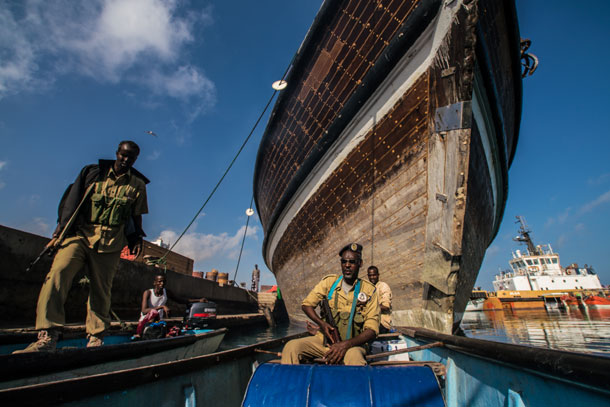
In the port of Bosaso, a team of guards prepares to head offshore and up the coast of Puntland, Somalia. (Photo: Courtesy of The Outlaw Ocean)
CURWOOD: So, there you are hiding on the roof. You've ordered up some security to escort you out to the one plane in the next two or three days. Take us to that moment. What do you hear?
URBINA: Yeah, so I had a special satellite device, so I was still able to text with sources. And the CIA has a drone base not far, and I knew some people over there, and there were no Westerners in our area. And Shabaab was moving in and blowing stuff up, heading towards the compound where we were and I was getting a lot of intel that was saying, you know, there's a lot of chatter about you guys. Everyone knows you're in there and it's not good, and you need to get out quickly, but we had no way out. And I had a fixer who was an American, based in Kenya, who knew the fish scene. I had Fabio, my Brazilian photographer and myself. And the intel we were getting streaming in was saying, you got to get out, you're persona non grata. The Puntland government said they are more than displeased with you, because they don't want you investigating these Thai vessels that are there and they're convinced you're CIA, et cetera, et cetera. Then we started getting even more worrisome intel, which was that within our security detail, we had about 20 guys, there were folks who were loyal to the president of Puntland et cetera. And so our threat was internal, not just external. So then I got really nervous. We had this meeting with the head of security at the compound and myself and the one guy that I really trust who, a guy named Tigey who was a tribal kind of figure and and very loyal and probably saved my life. And Tigey and I decided our plan was to make it look like we were still in the room. Because there was a courtyard that could see where we were staying. Leave the lights on, pull the drapes, make it look like we're staying there, let all of our security go except for Tigey's three cousins, who he knew to trust. And then we would quietly go to the roof and hide out there, but very few people would know we were there. And if a hit occurred, it would hit on our room. And then we would do what? I don't know, I guess sort of try to run, but where to? These are not questions I had clear answers for. So that's exactly what we did. We hid up on the roof for our final night. And there was a plane that was going to be brought in early for us. And we just needed to make it to the next morning. And so we hid up there for that night. Then, the next morning, our plan was to get certain guards that Tigey could call in to help us get to the airport. The roads from where we were to the airport were sort of very narrow roads, you're in a fishbowl. And these were the very roads that we would have to go through to get to the airport and there was really only one route we would follow. And everyone knew that there was one plane that had come in. So, everyone knew when those Western guys were going to leave the compound, because there was one plane. So it just seemed like a formula for us to get hit. And so our hope was to leave really early with some reinforcements. That plan didn't go well either, because the plane said they were going to leave early, and we had to go with no guards and just sort of make a run for it. And during our run, we were stopped by two pickup trucks full of armed guys who were not in uniform. And I thought, we have these SOS buttons on our iPhones and I had given the fixer and the photographer clear orders on if we got stopped and pulled out, here's what we should all do. And there we were, stopped and being pulled out. And that was, you know, kind of the scariest moment of the time, but in the end, it turned out that these were Tigey's guys. So we were very lucky and these guys sort of pulled us out, checked us out, and then put us back in and we raced to the airport and got out.
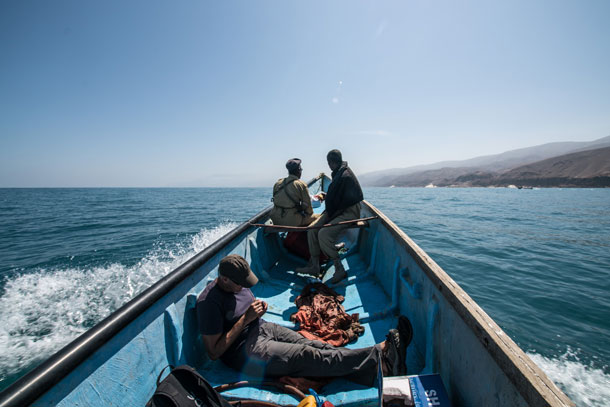
Ian Urbina (center bottom) was told to sit on the floor of the boat to avoid being seen from shore as he and his team travel up the coast of Puntland. (Photo: Courtesy of The Outlaw Ocean)
CURWOOD: Did you kiss the airplane?
URBINA: [LAUGHS] I kissed the ground, I kissed many people. I can't even remember who.
CURWOOD: There's a line at the end of your book. And it's going to be better in your voice. This is from page 408 of The Outlaw Ocean.
URBINA: Yeah, so. The ocean is outlaw not because it is inherently good or bad but because it is a void, like silence is to sound or boredom is to activity. While we have for centuries embraced and touted the life that springs from these waters, we have tended to ignore its role as a refuge of depravity. But the outlaw ocean is real, as it has been for centuries, and until we reckon with that fact, we can forget about ever taming or protecting this frontier.
CURWOOD: So, what's the fix?
URBINA: What's the fix?
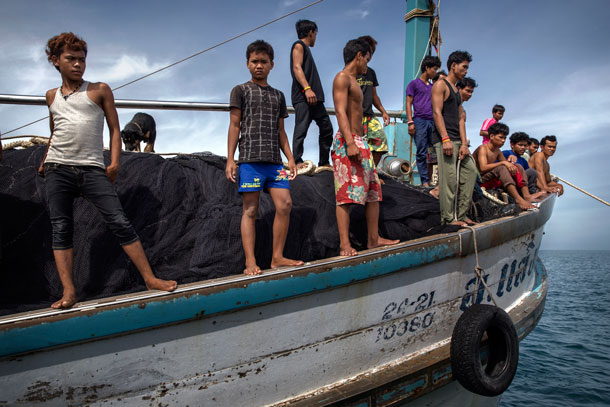
A crew of possibly enslaved Cambodian boys and men work on a Thai fishing ship, several hundred miles off the coast of Thailand in the South China Sea. (Photo: Courtesy of The Outlaw Ocean)
CURWOOD: Yeah, some say the ocean is just too big. It's too vast to be brought to heel. And you would say?
URBINA: I would say, if I wrote a book about injustice, right, and someone said, so what do we do to stop injustice? I would probably say we start by not asking that question, because it's too broad. And I couldn't possibly answer at that altitude. Similarly, what do we do to fix the outlaw ocean? That's kind of like how do we win the war? And I would immediately say, don't think about the war. Just choose your battles, and figure out which of the specific components of that war are the ones that you feel most motivated to tackle, right? So again, if it's ocean dumping or plastic pollution or murder or protection of seafarers, or, you know how we handle stowaways post 9/11 or seafood supply chains. I think the smartest move is to not think about the war. I do think there are some solutions that are emerging that traverse those silos, that sort of cross them, that would benefit the environmental and the human rights and labor issues. So, for example, if you think of the aeronautics industry, if you were to walk up to a pilot of a 747, and say, so, you've called ahead, they know you're coming, we'll see you your entire route, you're going to keep that thing on. We know what cargo you're carrying. We know everyone on board, all their names are registered on both sides, et cetera, et cetera. These answers would be readily and easily answered, right? In much of the world, in the long-haul fishing realm, if you asked a boat captain these questions, they would look at you like you were crazy to even be asking those questions. So, there is a cultural issue that needs to be confronted that's in the maritime space that allows this realm and those who operate in it a certain level of liberty. That is a core problem in my view. And so, whether ships have a unique identifier, a license plate that everyone can see, that stays the same, and there are serious consequences if you attempt to change it, that would be one step. Not being normal or allowed to turn off your transponder and, in fact, imposing transponders that you can't turn off at all, another thing that could be a big step forward. These are lofty ideals, difficult to actually implement, but could be a big step forward to actually tracking who's moving what, where and how and what's happening to the fish and the people that work there.
CURWOOD: And I have to ask this as well. Through all these difficult situations, share with us an uplifter.
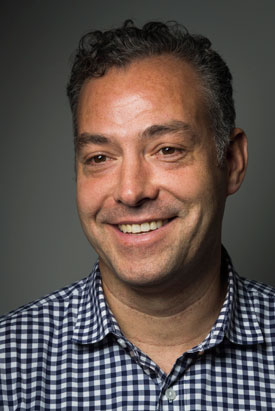
Ian Urbina is a Pulitzer Prize winning journalist and author of Outlaw Ocean. (Photo: © Jabin Botsford)
URBINA: There's a lot of beauty out there, both in the space and the people. That's why I often say like, it's extralegal. Even sometimes it's purely illegal, but it's not always bad. The characters I met along the way, the sort of underground network of anti-trafficking advocates who specialize in helping sea slaves, essentially, debt-bonded or even just shanghaied workers, some of them shackled, escape is really inspiring. And often those guys are breaking laws. The Rebecca Gomperts types that are out there trying to use the law in creative ways and use the high seas in creative ways to help in their view, I think are really impressive. And then also just, for all the gloominess of the reporting and the abuses it highlights, for the most part, the crew on these vessels, some of them as young as 13, their will to survive, their sort of scrappy ingenuity to make the time pass, their camaraderie, their sense of humor, their work ethic is really inspiring. They're not sort of downtrodden, somber faced, even in the midst of really harsh conditions. So I find those things inspiring.
CURWOOD: Ian Urbina's new book is called The Outlaw Ocean: Journeys Across the Last Untamed Frontier. Ian, thanks so much for spending the time with us.
URBINA: Thank you.
Related link:
The Outlaw Ocean’s official website
[MUSIC: Marian McPartland, “Yesterdays” on Timeless, by Otto Harbach-Jerome Kern, Savoy Ja]
O’NEILL: Just ahead, Champions of Spain’s marine marvels. Keep listening to Living on Earth!
ANNOUNCER: Support for Living on Earth comes from the estate of Rosamund Stone Zander - celebrated painter, environmentalist, and author of The Art of Possibility – who inspired others to see the profound interconnectedness of all living things, and to act with courage and creativity on behalf of our planet. Support also comes from Sailors for the Sea and Oceana. Helping boaters race clean, sail green, and protect the seas they love. More information @sailorsforthesea.org.
[MUSIC: Marian McPartland, “Yesterdays” on Timeless, by Otto Harbach-Jerome Kern, Savoy Ja]
The "Little Sea" with a Big Champion

Teresa Vicente is a professor of philosophy of law at the University of Murcia. (Photo: Goldman Environmental Prize)
CURWOOD: It’s Living on Earth, I’m Steve Curwood.
O’NEILL: And I’m Aynsley O’Neill. Our next two guests have worked tirelessly to protect the beautiful but fragile coastal ecosystems of Spain. The Mar Menor or “little sea” lagoon on the coast of Murcia, Spain, used to be a pristine saltwater home to a vital marine ecosystem. But mining, agriculture, and a booming tourist industry have threatened this fragile coastal area. Teresa Vicente is a professor of philosophy of law at the University of Murcia and she spearheaded a grassroots movement to protect the beloved Mar Menor. Her work led to the passage of a law in 2022 granting the lagoon legal personhood, the first recognition of legal rights for a European natural feature. For her activism, Teresa was granted the 2024 Goldman Environmental Prize for Europe and she joined me to share her story.
O'NEILL: So tell me about the Mar Menor, or “little sea” lagoon in Murcia, Spain. What is so special about this ecosystem?

Ms. Vicente spearheaded a movement to provide legal personhood to Mar Menor, the largest permanent saltwater lagoon in Europe. (Photo: Goldman Environmental Prize)
VICENTE (TRANSLATED): The Mar Menor is a saltwater lagoon that's 130 square kilometers with a sand dune that separates the lagoon from the Mediterranean. These sand dunes used to be marvelous, but now they're occupied by unsustainable urbanization. And the basin of the lagoon, which also has rights because it's in the same ecosystem, is 1,660 square kilometers. Since the 1960s, it's been severely impacted by the mining industry because the runoff from mining would spill and make its way into the lagoon. During the 70s, there was a lot of development and urbanization in the watershed and basin. And in the 80s, the agricultural industry and intense cattle farming really provoked the lagoon's collapse. And in recent decades, agriculture and livestock have definitely been the biggest threats to the lagoon.
O'NEILL: And Teresa, with all of these issues, what inspired you to work to protect Mar Menor?
VICENTE (TRANSLATED): For all Murcians, as well as for the Spanish community, but especially for Murcians, the Mar Menor is a vital part of our cultural identity. We're emotionally attached to it, and it forms an integral part of our lives. And in 2016, when Mar Menor's wildlife was dying right in front of our eyes, that's when the community started to wake up to what was happening. I'm from the generation that’s seeing the effects of climate change firsthand. So I started to ask myself, why does social responsibility law not account for how humans are responsible for the destruction of nature? And I had already been studying for a while the possibility of granting rights to nature. So I presented my idea to the community and they agreed that we need to recognize and defend the lagoon and its right to live.

In recent decades, rapid urbanization and a tourist boom have threatened the ecosystem. (Photo: Goldman Environmental Prize)
O'NEILL: And so you've been working on this for a number of years. You were even collecting signatures during COVID-19 lockdowns. What steps did you have to take in order to move this idea from, we should get legal rights to this lagoon, to actually getting the Spanish government to agree and grant these rights?
VICENTE (TRANSLATED): So when the great die-off happened in Mar Menor in October of 2019, I was studying at Reading University in the UK, and I was already looking into previous international legal cases that resulted in the recognition of rights of nature. I was studying what legal steps you have to take to turn a philosophical idea into concrete rights for nature. The two biggest examples I found were the Rio Atrato in Colombia, and the other case was the Whanganui River in New Zealand. So I learned what processes worked in those cases and then researched a plan for Mar Menor alongside my law students at the school. At that time, there was already a social movement that involved asking politicians and scientists why Mar Menor had been damaged, and what kind of solutions could fix the problem. And I was one of the professionals asked to participate. During a meeting at the public plaza, I explained my research and argued that the solution was to recognize that Mar Menor is living, and it has a right to life. That is, it has the right to be protected, to be repaired, to be conserved. And at that moment, the people involved in the movement transformed their sadness into happiness and their desolation into hope. And that's when we realized we were all going to fight together to make sure Mar Menor had its own rights.

Ms. Vicente has studied the rights of nature for decades and used her knowledge to fight for the protection of Mar Menor. (Photo: Goldman Environmental Prize)
O'NEILL: So as I understand it, this is the first time an ecosystem in Europe has been afforded these legal rights. It's really groundbreaking work. What does this new legal status mean for Mar Menor, and what are you hoping it'll mean for the future of environmental protection?
VICENTE (TRANSLATED): The significance of this win is that Mar Menor has received its rightful recognition as another living being that is part of humanity. It means that we're not separate from natural ecosystems, but we're alive thanks to them. Our human development models have to work within the limits of the natural world. We have to respect nature, live in harmony with it and not just use it for economic gain. I hope that this can set an example all across Europe and help the communities that are fighting for the rights of endangered ecosystems.
O'NEILL: Teresa Vicente is a Goldman Prize recipient and professor at the University of Murcia. Teresa, thank you for joining us today, and congratulations.
VICENTE: Thanks a lot.
Related links:
- Watch Teresa Vicente’s profile video from the Goldman Environmental Prize
- Read Teresa Vicente’s profile from the Goldman Environmental Prize
[MUSIC: Joshua Bell & Edgar Meyer, “BT” on Short Trip Home, by Edgar Meyer, Sony Classical]
Protecting Tenerife's Marine Marvels

Port construction can have major environmental impacts on the ocean such as damaging the seabed and creating coastal runoff. (Photo: Megha Engineering and Infrastructures Ltd, Wikimedia Commons, Public Domain)
CURWOOD: The Spanish archipelago known as the Canary Islands, just off the coast of Morocco, is home to diverse coastal ecosystems. And one of the recipients of the 2025 Goldman Environmental Prize was recognized for his work to protect the island of Tenerife in the Canary Islands from destruction. Carlos Mallo Molina was previously a civil engineer who also loved scuba diving. When he found out about plans to build a massive port on Tenerife that could have devastated the local marine life, he decided to leave construction and dedicate his career to protecting the oceans. Here’s our conversation.
CURWOOD: So let's begin by having you describe the marine protected area in the Canary Islands that's of so much concern.
MOLINA: So, yeah, the Canary Islands are our Spanish Hawaii, so you can imagine, and Tenerife is the biggest island of the eight, and in the southwest of the island, there is this marine protected area that is called the Zona Especial Conservación Teno-Rasca, which means a special protecting zone, which is an MPA or a marine protected area. And why it’s protected is because there is so much life. We have population of whales all year round. We have sharks. We have like a giant squid. We have like invertebrates, sea turtles. It's just a hot spot of biodiversity in Tenerife.
CURWOOD: And how big is the marine protected area, by the way?
MOLINA: So it's 170,000 acres, or 70,000 hectares, which is roughly 60 kilometers by 8 kilometers, more or less.

The ocean is home to beauty, but also a multitude of marine animals and species and is the biggest carbon sink. (Photo: Michal Strzelecki, Wojtek Strzelecki & Jerzy Strzelecki, Wikimedia Commons, Public Domain)
CURWOOD: Just describe Fonsalía for me right now.
MOLINA: So Fonsalía is a port that was going to be hosting 470, recreational boats, big ferries, cruises, just a lot of ships. The shape of the port was going to be a mega port with an island port. So basically it's rounded. It's a very different shape of port that has a lot of impact underwater seabed. And basically it was going to be the connection with the, what we call in the Canary Islands, is the green islands. So it's the La Gomera, La Palma and El Hierro. So, yeah, that's, that's pretty much it.
CURWOOD: So going from constructing a road to the port to being a Marine conservationist is a bit of a leap. Tell me about the day that you said, well, woah, wait a second, I've got to change what I'm doing.
MOLINA: Yeah. So I think working in Tenerife as an engineer and like understanding the impact that engineers can do with construction, and being aware that sometimes as an engineer, we try to do environmental assessment, but when it comes to the reality, the assessment is far away from the impact that we are actually doing. It opened my eyes to think that the construction should change, and it was when I realized all the impact that I could change by changing my life and doing something meaningful for the environment. I just decided to jump into the marine conservation field.
CURWOOD: And so you created the non-governmental organization, Innoceana, in part to combat this infrastructure development. Tell me, how did the establishment of your group help support the fight against the port?
MOLINA: In 2018, 2019 the government started talking about Fonsalía like, hey, we are going to start thinking about building this port finally, because this port is from the last century. So the planification of the port started in at the end of the 20th century. So when all of this started again to be a reality, we just put the effort of the organization in supporting this citizen platform called Salvar Fonsalía. And in this platform there were amazing people, from biologists to lawyers, and I was the engineer. So I was the civil engineer who used to be on the other side of development, and I changed into this side, so that, I think that key role was important to convince the authorities that it's not just about biologists trying to save the whales. Also, there is engineers and there is other people that want to do something good for this place.

Ships can be a major disturbance for whales and other sea creatures, causing stress. (Photo: al_green, Flickr CC BY-NC-ND 2.0)
CURWOOD: Let's just think about it. I'm at the surface, building a port, rebuilding a port that was fairly old, would seem like a smart move for boosting the local economy there on Tenerife. To what extent was there pushback from those in favor of the port?
MOLINA: Yeah, one of the biggest barriers was my own engineering group. So I'm part of the charter civil engineers of the Canary Islands. So my own, let's say family of engineers, were the most interested in building this port, because, you know, construction companies will make this happen. And they were very interested on having this, this development going on, right? So that was a big pushback. They tried to make this port from the very beginning, and I spent so much time speaking to them, speaking to my, my colleagues, and trying to convince them that was not necessary. One of the things that we used to convince a lot of people is when this port was planned many years ago, like over almost 30 years ago, there was no knowledge about how important was this marine protected area we were speaking about. So, and having all of this information, this new information, was key, and also having Europe on our side, because the European Union is very interested in protecting the nature, which is something I'm proud of. That was all of that combination of things was very important.
CURWOOD: What's been the quality of that biological diversity over the years? How much has it declined?
MOLINA: So there is different ecosystems and different like animals living there. So for instance, when you speak about the seagrass, the seagrass is these plants that live under the ocean and they produce a lot of oxygen and sequestrate carbon. They are carbon sinks. We lost, according to our own studies with my organization, we lost at least like 60% of them in the last 20 years, according with the data from the past. But when it comes to the whales, the population of whales is still there. It hasn't been declined, but the level of cortisol, the level of stress, is just increasing because all of the tourism and all the pollution and, you know, all of the all of the stressors. So yeah, there is definitely getting worse and worse.

Carlos loves the ocean and is the happiest when scuba diving. (Photo: Goldman Environmental Prize)
CURWOOD: So talk to me about what would have happened to nature with the construction of this port, what was wanting to be done?
MOLINA: Yeah. So first of all, there is, like, different levels of in the construction a port. First you have the actual construction, and then you have the kind of the operation of the port, right? So it's different impacts. When you are building the port, the first thing you are going to do is to destroy the seabed, so you are going to put a lot of land under the water to just create an island, basically, that is going to be the all the filling of the port. And that's so bad for basically, all of the seagrass, all of the invertebrates, all of the animals that live by the coast. But then when it comes to the operation of the port, is when you have like, 1000s and 1000s of boats and ships coming every day and moving and if you think about this, as in the middle of the marine protected area, you have this port. You can imagine all of these port ships as like arrows and like going around and like disturbing the whales, polluting and, you know, just having a lot of impact on the environment, it's like, imagine you have, like a national park where you have thousands of cars going everywhere, not only on the road, but outside of the roads. Will be really bad.
CURWOOD: Carlos, I think it's pretty clear that you put in exhaustive hours in this campaign. So now the question that I'm sure is on everyone's mind listening to us, to what extent does this story have a happy ending?
MOLINA: Yeah, I'm so happy that you are asking me for this question, because when the government changed their mind, and they were like, okay, we are now against the port, and all of the Fonsalía platform, like all these citizen platforms, were so happy to celebrate that the port wasn't going to happen. Myself, along with my team and other partners, we continue working on, okay, this is not the end. We need to do something more. We need to really create something in this place to really have a happy ending. And this is where we started asking to Europe for funding to create a marine conservation and education center in the area where the port was going to be built. And two years ago, we got the announcement that Europe gave us the fundings. And this project is called Hope, and for many reasons, but of course, it's because it's bringing hope to this area, and it's very focused on working with the communities and being able to teach the communities about how important is this marine protected area that is connected to all of the Macaronesia. So now we are building this Marine Conservation Center, and I'm hoping that this is the real way to finish with the problem, a root problem of development and gentrification that is happening in the Canary Islands.

Tenerife is the biggest of Spain’s Canary Islands, hosting more than 5 million tourists a year. (Photo: Salvador Aznar)
CURWOOD: Anything more you want to tell us?
MOLINA: Yeah, Hope is a very beautiful project, also because it's opening to Africa. So we have partners in Senegal, Ghana, São Tomé and Príncipe and in Cape Verde, and along with Portugal, so we are actually partnering this marine conservation center is in a network of other countries, and because there is so much work to do in conservation across the Macaronesia that is all of this region. So it brings a lot of hope to think about this.
CURWOOD: What's your happiest moment these days now, when you come down to this area that was going to be a port and now is this conservation site that you call Hope, Esperanza. What do you think of most?

Carlos adjusted his career path by switching from civil engineer to a marine conservationist. (Photo: Goldman Environmental Prize)
MOLINA: You know, for me, the happiest moment for me is when I am under the water, so when I'm scuba diving, because that's my passion, and just being in the area where the port was going to be built, and being scuba diving there, and just thinking about it, it's just, it makes me break in tears every time I'm underwater. Under my mask, I am almost crying because it's so beautiful and it's so pristine and so amazing, that thinking that the humans can really make a good change for the environment and for the future is just it brings me a lot of happiness and hope.
CURWOOD: So what's next for you?
MOLINA: Yeah, well, I think I keep telling myself what is next is to not to give up in this world, because it's very hard, like at least three times a year I am about to give up, saying this is impossible, but I always keep going. So I think using this opportunity of the Goldman prize to go to the next level and be able to maybe start, I like to see that in the future, we are going to start projects in Africa and working with other countries and, and use this model in the Canary Islands as standard that we can replicate in other places and and like create a ripple effect that really makes a difference for the ocean.
CURWOOD: Well, I want to thank you. Carlos Mallo Molina is the CEO of Innoceana and a winner of this year's Goldman prize for the island states. Thank you so much.
MOLINA: Thank you guys. It's an honor for me to be here. Thank you so much.
Related links:
- Learn more about Innoceana and the work they’re doing
- Hear more about Carlos’s story
- Read about Carlos Mallo Molina and the Goldman Prize
[MUSIC: Soul Jazz Express, “Closer Than You Think” on Soul Jazz Express]
CURWOOD: Living on Earth is produced by the World Media Foundation.
Our crew includes Naomi Arenberg, Paloma Beltran, Jenni Doering, Daniela Faria, Swayam Gagneja, Mark Kausch, Mark Seth Lender, Don Lyman, Ashanti Mclean, Nana Mohammed, Sophia Pandelidis, Jake Rego, Andrew Skerritt, Bella Smith, Melba Torres, and El Wilson.
O’NEILL: Tom Tiger engineered our show. Alison Lirish Dean composed our themes.
You can hear us anytime at L-O-E dot org, Apple Podcasts and YouTube Music, and like us please, on our Facebook page, Living on Earth. Find us on Instagram at living on earth radio, and we always welcome your feedback at comments at loe.org. I’m Aynsley O’Neill.
CURWOOD: And I’m Steve Curwood. Thanks for listening!
ANNOUNCER: Funding for Living on Earth comes from you, our listeners, and from the University of Massachusetts, Boston, in association with its School for the Environment, developing the next generation of environmental leaders. And from the Grantham Foundation for the protection of the environment, supporting strategic communications and collaboration in solving the world’s most pressing environmental problems.
ANNOUNCER 2: PRX.
Living on Earth wants to hear from you!
Living on Earth
62 Calef Highway, Suite 212
Lee, NH 03861
Telephone: 617-287-4121
E-mail: comments@loe.org
Newsletter [Click here]
Donate to Living on Earth!
Living on Earth is an independent media program and relies entirely on contributions from listeners and institutions supporting public service. Please donate now to preserve an independent environmental voice.
NewsletterLiving on Earth offers a weekly delivery of the show's rundown to your mailbox. Sign up for our newsletter today!
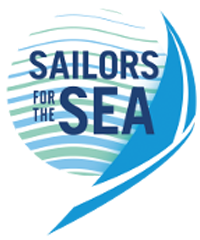 Sailors For The Sea: Be the change you want to sea.
Sailors For The Sea: Be the change you want to sea.
 The Grantham Foundation for the Protection of the Environment: Committed to protecting and improving the health of the global environment.
The Grantham Foundation for the Protection of the Environment: Committed to protecting and improving the health of the global environment.
 Contribute to Living on Earth and receive, as our gift to you, an archival print of one of Mark Seth Lender's extraordinary wildlife photographs. Follow the link to see Mark's current collection of photographs.
Contribute to Living on Earth and receive, as our gift to you, an archival print of one of Mark Seth Lender's extraordinary wildlife photographs. Follow the link to see Mark's current collection of photographs.
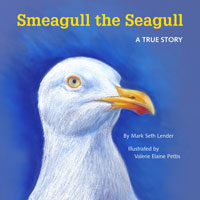 Buy a signed copy of Mark Seth Lender's book Smeagull the Seagull & support Living on Earth
Buy a signed copy of Mark Seth Lender's book Smeagull the Seagull & support Living on Earth

